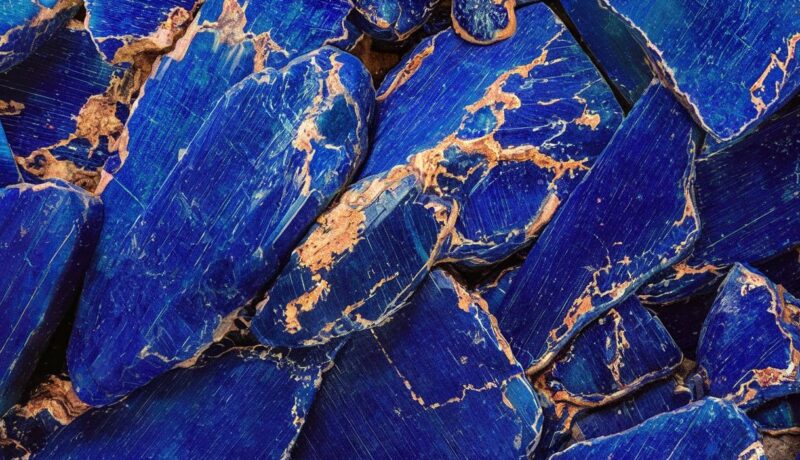Lapis lazuli is a gemstone that has captivated humanity’s imagination with its deep celestial blue hues for millennia. Today it continues to be a subject of fascination in the realms of geology, history, and metaphysical studies.
In this article, we look into the origins, characteristics, uses, and care of this blue gem, shedding light on why it has been treasured across civilizations and ages.
Key takeaways
- Lapis lazuli is a gemstone with a hardness rating of 5.5 on the Mohs scale.
- It’s mostly mined in Afghanistan, but there are also significant deposits in Chile, Siberia, Myanmar, Pakistan, and USA.
- It has a history spanning over 9000 years.
- Lapis lazuli was widely used throughout human history, from ancient Egypt, through the Renaissance until today.
- It’s believed that lapis lazuli possess metaphysical properties that connect to the throat and third eye chakras.
Origins and Deposits
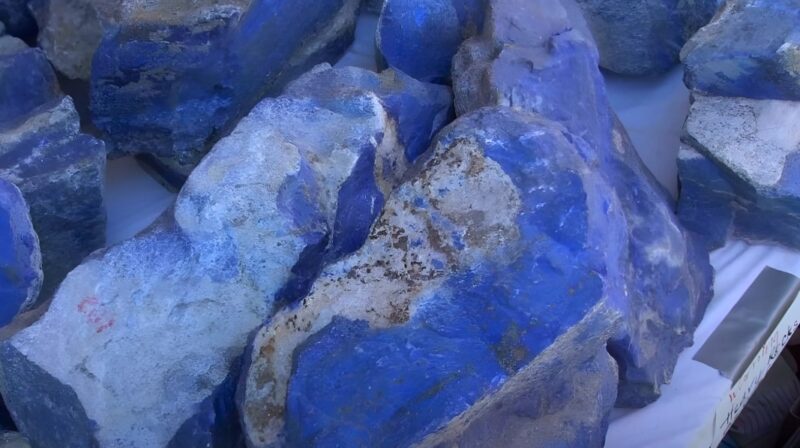
Afghanistan stands out as the premier source of top-quality lapis lazuli, a distinction it has held for thousands of years. The Sar-e-Sang mines in Afghanistan’s Badakhshan province have been the epicenter of lapis lazuli mining since ancient times, offering stones with the most sought-after deep violet-blue to turquoise blue colors. Besides Afghanistan, there are significant deposits in Chile, particularly in the Andes mountains, where the stone exhibits a slightly different color palette. Other notable sources include:
- Siberia
- United States (California and Colorado)
- Myanmar
- Pakistan
Each of these countries contributes to the global supply of this gemstone with varying grades based on color and the presence of calcite or pyrite.
Historical Significance
Lapis lazuli’s impact on human civilization is profound, with its use dating back to ancient Mesopotamia, Egypt, China, Greece, and Rome.
Ancient Egypt
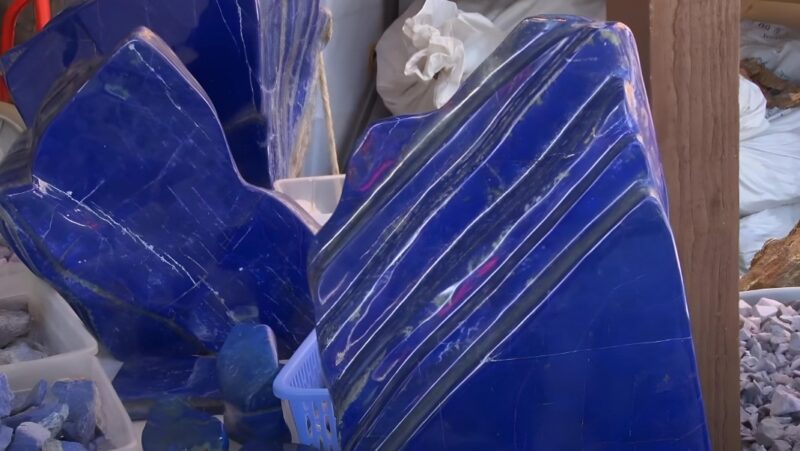
Ancient Egyptians associated lapis lazuli with the night sky and the vastness of the universe, drawing parallels between the stone’s deep blue hue and the celestial realm. This connection was not merely aesthetic but deeply spiritual, as they believed lapis to possess the power to guide souls in the afterlife, offering protection and a promise of eternal life. Such was the stone’s significance that it found its way into the most sacred and revered objects and places.
One of the most iconic uses of this gem in ancient Egypt was in the funeral mask of Tutankhamun. The mask, discovered in the pharaoh’s tomb, features lapis lazuli prominently, inlaid among gold and other precious stones. The inclusion of lapis in this mask was symbolic, meant to ensure the pharaoh’s divine protection and safe passage into the afterlife. This highlights the stone’s association with royalty and divinity, underscoring its importance in the burial practices of ancient Egypt.
Renaissance
During the Renaissance period, lapis lazuli assumed a new role as the source of the pigment ultramarine. During this period, renowned artists used the pigment derived from the finest quality lapis lazuli to create masterpieces.
Michelangelo, for instance, incorporated ultramarine in his frescoes on the Sistine Chapel ceiling, notably in the depiction of the Last Judgment. Similarly, the Dutch master Johannes Vermeer used this rich blue in “The Girl with a Pearl Earring“ showcasing the depth and vibrancy that only true ultramarine could achieve.
Metaphysical Properties
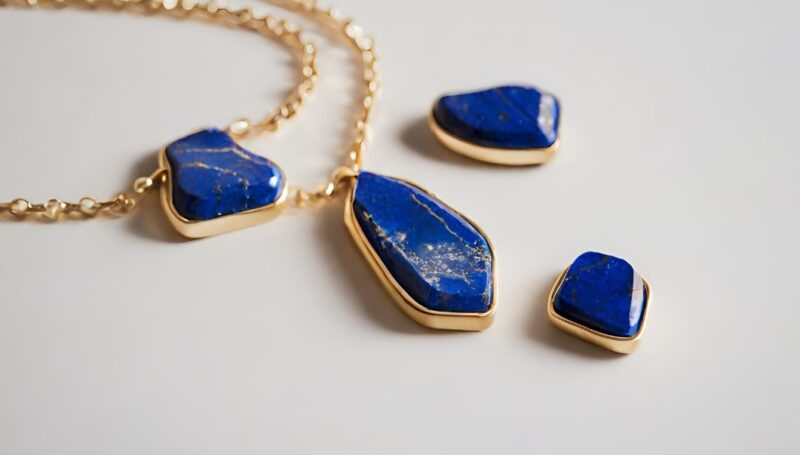
Believers attribute metaphysical properties to lapis lazuli, claiming it connects with the throat and third eye chakras. It supposedly fosters awareness, harmony, and inner peace, making it sought after by those aiming to deepen their spiritual journey. This gemstone, also December’s traditional birthstone, aligns with the Capricorn and Libra zodiac signs, adding to its astrological allure.
Care and Maintenance
To preserve lapis lazuli’s beauty and prevent damage, one must handle it with care. Its porous and delicate nature necessitates cleaning with mild dish soap and a soft brush.
Owners should store their jewelry and accessories separately to prevent scratches and remove them before sleeping to avoid exposure to chemicals and solvents. A natural cleaning alternative involves washing the stone in the shower to remove dirt gently.
Similar Stone to Lapis Lazuli – meet Sodalite
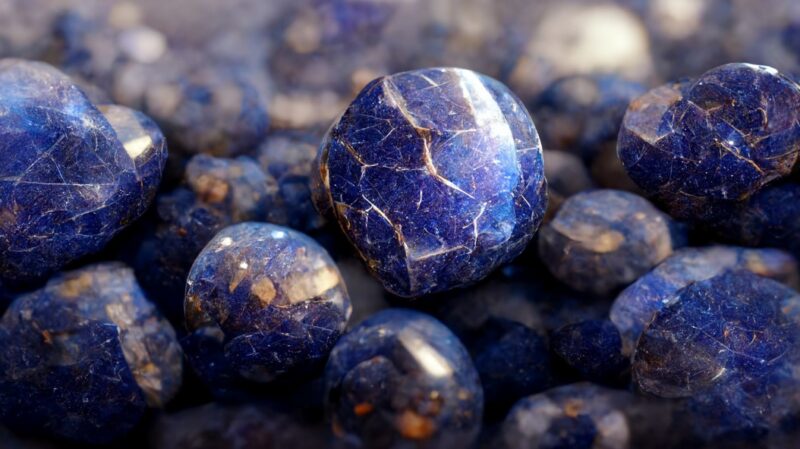
Lapis lazuli and sodalite can easily be mistaken for one another due to their captivating blue hues, several distinctions set them apart. Both stones have been admired across various cultures for their beauty, but understanding their differences is key for gem enthusiasts and collectors.
Color
Lapis Lazuli is primarily composed of lazulite and often contains inclusions of pyrite and calcite, giving it a unique sparkle and texture. Its deep, even blue color has made it a sought-after gemstone in jewelry and decorative objects for centuries. In contrast, sodalite, a member of the feldspathoids mineral group, presents a more mottled or blotchy appearance.
This difference in coloration can help distinguish between the two, despite their superficial similarities.
Form
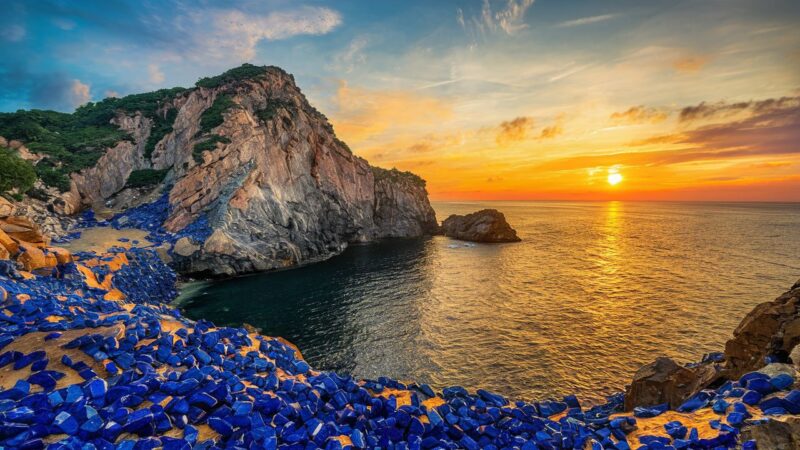
Sodalite can be found in both transparent and translucent forms, adding a layer of versatility not seen in lapis lazuli, which is always opaque. This transparency in sodalite can create depth and clarity in the stone that appeals to many.
Presence of Pyrite Inclusions
Another point of differentiation is the presence of pyrite inclusions. These metallic inclusions are common in lapis lazuli, contributing to its shimmering appearance, but they are not found in sodalite. The absence of pyrite gives sodalite a more uniform look, though it lacks the golden sparkle that characterizes lapis lazuli.
Besides these differences, sodalite’s rich blue color and aesthetic appeal make it a popular choice for those looking for alternatives to lapis lazuli. While lapis lazuli continues to hold a more prestigious position in the world of gemstones, sodalite offers its own unique beauty, making it a desirable option for jewelry and decorative items.
Lapis Lazuli Today
Artists and designers value this gem for its deep blue hues, integrating it into contemporary jewelry, fashion accessories, and luxury home decor. Beyond its aesthetic appeal, the wellness and spiritual communities celebrate this gemstone for its purported healing properties, using it in practices that promote self-awareness and inner peace.
FAQs
Can it fade in sunlight?
Yes, prolonged exposure to direct sunlight can cause lapis lazuli to fade. The ultraviolet rays can gradually lighten the vibrant blue color, so it’s advisable to store its pieces away from direct sunlight.
How can you tell if it’s real or fake?
Authentic lapis lazuli has a rich, deep blue color with natural variations, including flecks of pyrite (gold color) and calcite (white color). Fake ones often lack these natural inclusions or have a uniform, dyed appearance. A simple test is to look for imperfections as genuine gem will have a natural, uneven color distribution.
Is it more valuable than sapphire?
While both stones are valued for their beautiful blue hues, sapphires are generally more expensive due to their hardness, rarity, and the demand in the gemstone market. Yet, top-quality lapis lazuli with minimal calcite and vibrant pyrite can still fetch high prices.
What cultures besides the Egyptians and Renaissance Europeans valued this gemstone?
Numerous cultures have prized lapis lazuli, including the Mesopotamians, Persians, and Buddhists in Asia. For Buddhists, it’s considered a stone that brings inner peace and freedom from negative thoughts, often used in rituals and decorative art.
Can it be used in water?
While lapis lazuli can be washed with water, prolonged exposure or soaking in water isn’t recommended. Its porous nature means it can absorb water, which might lead to discoloration or weakening of the stone over time.
Has it ever been used in medicine?
Historically, lapis lazuli was ground into a powder and used in various medical treatments, particularly in the Middle Ages. It was believed to be an antidote for snake bites and to have various other healing properties, though there is no scientific evidence to support these medicinal uses today.
Conclusion
The story of lapis lazuli, from the ancient mines of Afghanistan to its revered status across civilizations and into the modern era, is a testament to its enduring allure and significance. Its primary sources, including Afghanistan, Chile, Siberia, the United States, and Myanmar, contribute to the diverse spectrum of lapis lazuli available today, each with its unique characteristics and value. As we appreciate the beauty and historical importance of this gemstone, it’s crucial to also recognize the need for responsible sourcing and care to preserve its legacy for future generations.
